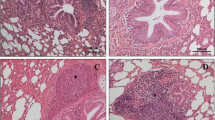Abstract
Almost 40 years ago, it was reported that cattle-feed which had been extracted with hot trichloroethylene and then fed to calves produced renal injury and a fatal aplastic anaemia. The toxic factor was subsequently identified as S-(1,2-dichlorovinyl)-L-cysteine (DCVC). These original findings have been confirmed, a single intravenous dose of DCVC at 4 mg/kg, or 0.4 mg/kg intravenously per day administered for 10 days to calves produced aplastic anaemia, and renal injury after a single dose of 4 mg/kg. The toxicity to calves of a number of other haloalkene cysteine conjugates has been examined to ascertain whether, like DCVC, they produce bone marrow and renal injury. Intravenous administration of the N-acetyl cysteine conjugate of DCVC produced renal but not bone marrow injury at a molar equivalent dose to DCVC, indicating that the calf can deacetylate the mercapturic acid and further that sufficient chemical had reached the kidney to be a substrate for the enzyme cysteine conjugate β-lyase. However, intravenous administration of the α-methyl analogue of DCVC, which cannot undergo metabolism via the enzyme cysteine conjugate β-lyase, was without toxicity at doses about five-fold higher than DCVC. These latter findings provide strong evidence that metabolism of DCVC via the enzyme β-lyase is necessary for bone marrow and renal injury to occur. The cysteine conjugates of perchloro ethylene and hexachloro-1,3-butadiene(HCBD) when given intravenously to calves at molar equivalent doses to DCVC, or above, did not produce either bone marrow or renal injury. In contrast, intravenous administration of the cysteine conjugate of tetrafluoroethylene (TFEC) produced severe renal tubular injury in calves without affecting the bone marrow. In vitro studies with these haloalkene cysteine conjugates showed, like DCVC, that they were good substrates for calf renal cysteine conjugate β-lyase and toxic to renal cells as judged by their ability to reduce organic anion and cation transport by slices of calf renal cortex and inhibit the renal enzyme glutathione reductase. Calves were also dosed either orally or intravenously with HCBD to assess its toxicity. HCBD at higher molar equivalent doses than DCVC produced mid-zonal necrosis in the liver, renal tubular necrosis but no bone marrow injury in calves. The key findings emerging from these studies are (1) that none of the other cysteine conjugates, at molar equivalent doses to DCVC and above, produce bone marrow injury in calves, (2) TFEC produced only renal injury, suggesting that sufficient of the other conjugates had not reached the kidney for metabolism by β-lyase to produce cytotoxicity and (3) that HCBD itself is more toxic than its cysteine or mercapturic acid conjugate, suggesting that pharmacokinetics and disposition are important factors in determining the toxicity of these conjugates to calves. Further studies are needed to understand the basis for the selective toxicity of DCVC to the bone marrow of calves.
Similar content being viewed by others
Author information
Authors and Affiliations
Additional information
Received: 16 October 1995/Accepted: 9 January 1996
Rights and permissions
About this article
Cite this article
Lock, E., Sani, Y., Moore, R. et al. Bone marrow and renal injury associated with haloalkene cysteine conjugates in calves. Arch Toxicol 70, 607–619 (1996). https://doi.org/10.1007/s002040050319
Issue Date:
DOI: https://doi.org/10.1007/s002040050319
- Key words S-(1
- 2-Dichlorovinyl)-L-cysteine
- S-(1
- 1
- 2-Trichlorovinyl)-L-cysteine
- (1
- 1
- 2
- 2-Tetrafluoroethyl)-L-cysteine
- S-(1
- 2
- 3
- 4
- 4-Pentachloro-1
- 3-butadienyl)-L-cysteine
- N-Acetyl-S-(1
- 2
- 3
- 4
- 4-pentachloro-1
- 3-butadienyl)-L-cysteine
- N-Acetyl-S-(1
- 2-dichlorovinyl)-L-cysteine
- S-(1
- 2-Dichlorovinyl)-DL-α-methylcysteine
- Hexachloro-1
- 3-butadiene
- Renal injury
- Aplastic anaemia
- Calves




